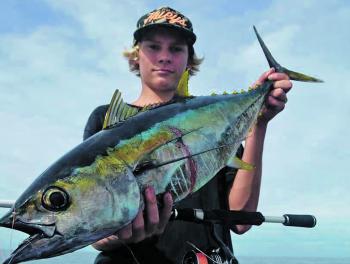Spring has promptly sprung to an end. Warmer days, howling northerlies and evening thunderstorms have set the scene for another cliché summer, but it’s not all sunburn and pedestal fans – summer brings with it a host of good fishing. The Tweed area particularly fires up this season. As the mercury rises, we can expect to see good scores of mangrove jack through the river and creeks. In the offshore department, mackerel, marlin, mahimahi, tuna and trevally should all start to push up the coast as the water temperature rises.
These oceanic speedsters respond well to most presentations, whether it’s a frozen pilly or a lively yakka, however, the recent surface lure fishing movement has devoured many anglers – myself included. It’s the most exciting visual form of fishing currently partaken in. To set up for this kind of fishing, use long spinning rods in the 7’6 to 8’3 range to maximise casting distance. Add to that a high-geared spinning reel capable of holding at least 300m of 60lb braid and dealing out a considerable amount of drag (15-30kg).
For lures, there are two main options – poppers and stickbaits. These work in particular conditions. Traditionally, poppers are thrown in slightly rougher conditions to grab attention and bring fish in from further away, while still providing an appealing presentation that many pelagics can’t turn down. In contrast, stickbaits are used in calmer water to provide a more subtle presentation while still alerting fish to their presence.
Poppers and stickbaits can be expensive for lures. Many of the best lures come from Japan, are handcrafted and have paint jobs that leave them looking like they should be preserved in an art gallery, rather than tossed around in search of toothy monsters to steal these $100 timber crafts.
Popular affordable stickbaits that are proven performers along the Tweed Coast include the CSP range of stickbaits by FCL, the DUO rough trail Aromosa and the Shimano Orca lures. As far as poppers go, the FCL Ebipop and Reefs Edge poppers are reliable choices and easy to get working along the surface. The most crucial part to offshore surface fishing is the retrieve and this varies from lure to lure.
The best thing to do is to go down to a local pond or river with the lures then practice your cast and experiment with different retrieves until you find the sweet spot. Most poppers will work with a blooping method made by a sharp movement in the rod tip, which causes the lure to push through the water splashing from the cup of the popper and creating an enticing bubble trail in its wake.
For stickbaits the most common retrieve is a long slow sweep of the rod tip followed by a pickup of the loose line. This is then repeated throughout the retrieve and can include pauses and speed changes. A straight, fast retrieve works well for fast fish like mackerel and wahoo. It can also trigger other pelagics to feed.
Along the Tweed Coast, we’re fortunate enough to have a host of reefs on our doorstep that attract pelagics through the summer months. Anywhere from Kingscliff to the Nine Mile is worth a crack, and often riddled with fish. An alternative to fishing the reefs is finding current lines or feeding schools – these areas may seem obvious, but can really produce in the right situations.
1
The Tweed Coast has a host of reefs that attract pelagics.
2
The warmer water brings in a bunch of new species.
3
A whopper GT – you’d need tough gear to pull in that beast!
4
The recent surface lure fishing movement has devoured many anglers – the author included.
5
Mangrove jack are heating up inshore.
Reads: 2636








